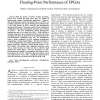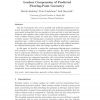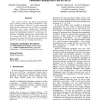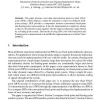TVLSI
2008
14 years 2 months ago
2008
With the density of FPGAs steadily increasing, FPGAs have reached the point where they are capable of implementing complex floating-point applications. However, their general-purpo...
TVLSI
2008
14 years 2 months ago
2008
Recently, it has become possible to implement floating-point cores on field-programmable gate arrays (FPGAs) to provide acceleration for the myriad applications that require high-p...
CAD
2005
Springer
14 years 3 months ago
2005
Springer
The size of geometric data sets in scientific and industrial applications is constantly increasing. Storing surface or volume meshes in standard uncompressed formats results in la...
SIAMSC
2008
14 years 3 months ago
2008
In this Part II of this paper we first refine the analysis of error-free vector transformations presented in Part I. Based on that we present an algorithm for calculating the round...
FPL
2006
Springer
14 years 6 months ago
2006
Springer
FPGAs have reached densities that can implement floatingpoint applications, but floating-point operations still require a large amount of FPGA resources. One major component of IE...
FPGA
2006
ACM
14 years 6 months ago
2006
ACM
Due to their generic and highly programmable nature, FPGAs provide the ability to implement a wide range of applications. However, it is this nonspecific nature that has limited t...
FPL
2004
Springer
14 years 6 months ago
2004
Springer
Abstract. This paper presents a new data representation known as Dual FiXedpoint (DFX), which employs a single bit exponent to select two different fixedpoint scalings. DFX provide...
ARITH
2007
IEEE
14 years 7 months ago
2007
IEEE
The IEEE Standard 754-1985 for Binary Floating-Point Arithmetic [1] was revised [2], and an important addition is the definition of decimal floating-point arithmetic. This is inte...
ICC
2008
IEEE
14 years 9 months ago
2008
IEEE
—In this paper, we present a floating-point compression method using position prediction for haptic data transmission. The main objective of our work is to reduce the size of ban...




